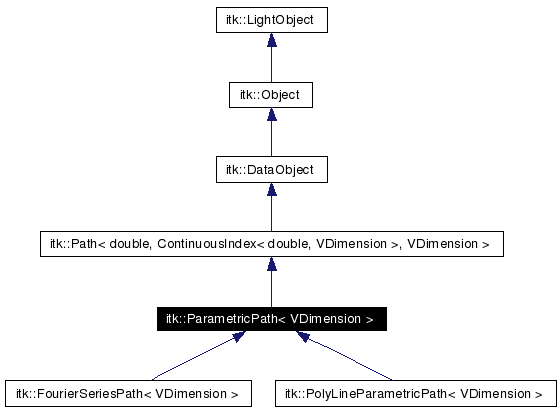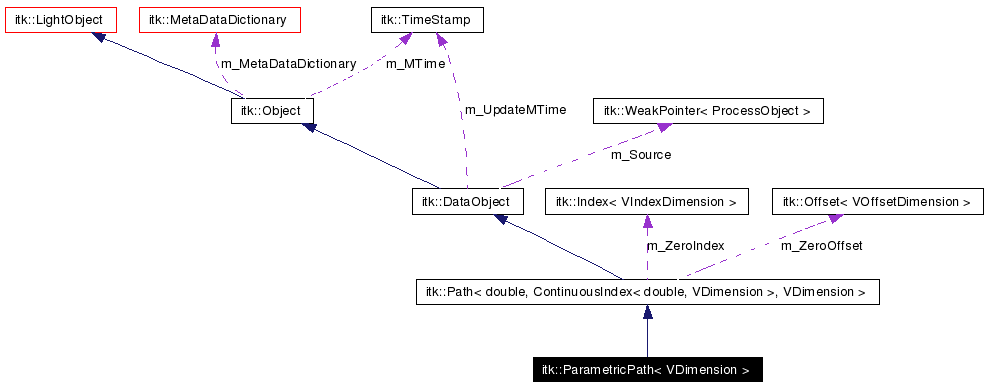
#include <itkParametricPath.h>
Inheritance diagram for itk::ParametricPath< VDimension >:


Public Types | |
| typedef ParametricPath | Self |
| typedef Path< double, ContinuousIndex< double, VDimension >, VDimension > | Superclass |
| typedef SmartPointer< Self > | Pointer |
| typedef SmartPointer< const Self > | ConstPointer |
| typedef Superclass::InputType | InputType |
| typedef Superclass::OutputType | OutputType |
| typedef ContinuousIndex< double, VDimension > | ContinuousIndexType |
| typedef Index< VDimension > | IndexType |
| typedef Offset< VDimension > | OffsetType |
| typedef Vector< double, VDimension > | VectorType |
Public Member Functions | |
| virtual const char * | GetNameOfClass () const |
| virtual IndexType | EvaluateToIndex (const InputType &input) const |
| virtual OffsetType | IncrementInput (InputType &input) const |
| virtual VectorType | EvaluateDerivative (const InputType &input) const |
| virtual void | SetDefaultInputStepSize (InputType _arg) |
| virtual const InputType & | GetDefaultInputStepSize () |
Protected Member Functions | |
| ParametricPath () | |
| ~ParametricPath () | |
| void | PrintSelf (std::ostream &os, Indent indent) const |
Protected Attributes | |
| InputType | m_DefaultInputStepSize |
This virtual class is intended to represent a parametric path through an image. A parametric path maps a single floating-point 1D parameter (usually designated as either time or arc-length) to a floating-point ND point in continuous image index space. This mapping is done via the abstract Evaluate() method, which must be overridden in all instantiable subclasses. Parametric paths are required to be continuous. They may be open or form a closed loop. A parametric path may cross itself several times, although the end point is constrained to have a unique spatial location unless it is shared with and only with the starting point (a path tracing the number "9," starting at the bottom and ending in the middle of the right side, would therefore be illegal). Classic applications of this class include the representation of contours in 2D images and path smoothing. Another use of a path is to guide the movement of an iterator through an image.
OrthogonallyCorrectedParametricPath
Definition at line 62 of file itkParametricPath.h.
|
|||||
|
Reimplemented from itk::Path< double, ContinuousIndex< double, VDimension >, VDimension >. Reimplemented in itk::FourierSeriesPath< VDimension >, itk::OrthogonallyCorrected2DParametricPath, and itk::PolyLineParametricPath< VDimension >. Definition at line 70 of file itkParametricPath.h. |
|
|||||
|
All paths must be mapable to index space Reimplemented in itk::FourierSeriesPath< VDimension >, itk::OrthogonallyCorrected2DParametricPath, and itk::PolyLineParametricPath< VDimension >. Definition at line 83 of file itkParametricPath.h. |
|
|||||
|
All paths must be mapable to index space Reimplemented from itk::Path< double, ContinuousIndex< double, VDimension >, VDimension >. Reimplemented in itk::FourierSeriesPath< VDimension >, itk::OrthogonallyCorrected2DParametricPath, and itk::PolyLineParametricPath< VDimension >. Definition at line 84 of file itkParametricPath.h. |
|
|||||
|
Input type Reimplemented from itk::Path< double, ContinuousIndex< double, VDimension >, VDimension >. Reimplemented in itk::FourierSeriesPath< VDimension >, itk::OrthogonallyCorrected2DParametricPath, and itk::PolyLineParametricPath< VDimension >. Definition at line 76 of file itkParametricPath.h. |
|
|||||
|
Reimplemented from itk::Path< double, ContinuousIndex< double, VDimension >, VDimension >. Reimplemented in itk::FourierSeriesPath< VDimension >, itk::OrthogonallyCorrected2DParametricPath, and itk::PolyLineParametricPath< VDimension >. Definition at line 85 of file itkParametricPath.h. |
|
|||||
|
Output type Reimplemented from itk::Path< double, ContinuousIndex< double, VDimension >, VDimension >. Reimplemented in itk::FourierSeriesPath< VDimension >, itk::OrthogonallyCorrected2DParametricPath, and itk::PolyLineParametricPath< VDimension >. Definition at line 79 of file itkParametricPath.h. |
|
|||||
|
Reimplemented from itk::Path< double, ContinuousIndex< double, VDimension >, VDimension >. Reimplemented in itk::FourierSeriesPath< VDimension >, itk::OrthogonallyCorrected2DParametricPath, and itk::PolyLineParametricPath< VDimension >. Definition at line 69 of file itkParametricPath.h. |
|
|||||
|
Standard class typedefs. Reimplemented from itk::Path< double, ContinuousIndex< double, VDimension >, VDimension >. Reimplemented in itk::FourierSeriesPath< VDimension >, itk::OrthogonallyCorrected2DParametricPath, and itk::PolyLineParametricPath< VDimension >. Definition at line 67 of file itkParametricPath.h. |
|
|||||
|
Reimplemented from itk::Path< double, ContinuousIndex< double, VDimension >, VDimension >. Reimplemented in itk::FourierSeriesPath< VDimension >, itk::OrthogonallyCorrected2DParametricPath, and itk::PolyLineParametricPath< VDimension >. Definition at line 68 of file itkParametricPath.h. |
|
|||||
|
Reimplemented in itk::FourierSeriesPath< VDimension >, itk::OrthogonallyCorrected2DParametricPath, and itk::PolyLineParametricPath< VDimension >. Definition at line 86 of file itkParametricPath.h. |
|
|||||||||
|
|
|
|||||||||
|
Definition at line 124 of file itkParametricPath.h. |
|
||||||||||
|
Evaluate the first derivative of the ND output with respect to the 1D input. This is a very simple and naive numerical derivative, and it sould be overloaded with a proper closed-form derivative function in all children. Nevertheless, users who need to create their own parametric classes for their private research need not reimplement this function if their work does not need the derivative operator. Reimplemented in itk::FourierSeriesPath< VDimension >. |
|
||||||||||
|
Return the nearest index to the parametric path at the specified location. This is a wrapper to Evaluate(). Implements itk::Path< double, ContinuousIndex< double, VDimension >, VDimension >. |
|
|||||||||
|
|
|
|||||||||
|
Run-time type information (and related methods). Reimplemented from itk::Path< double, ContinuousIndex< double, VDimension >, VDimension >. Reimplemented in itk::FourierSeriesPath< VDimension >, itk::OrthogonallyCorrected2DParametricPath, and itk::PolyLineParametricPath< VDimension >. |
|
||||||||||
|
Increment the input variable passed by reference such that the ND index of the path moves to its next vertex-connected (8-connected in 2D) neighbor. Return the Index-space offset of the path from its prior input to its new input. If the path is unable to increment, input is not changed and an offset of Zero is returned. Children are not required to implement bounds checking. This is a fairly slow, iterative algorithm that numerically converges to the next index along the path, in a vertex-connected (8-connected in 2D) fashion. When possible, children of this class should overload this function with something more efficient. WARNING: This default implementation REQUIRES that the ND endpoint of the path be either unique or coincident only with the startpoint, since it uses the endpoint as a stopping condition. Implements itk::Path< double, ContinuousIndex< double, VDimension >, VDimension >. |
|
||||||||||||||||
|
Methods invoked by Print() to print information about the object including superclasses. Typically not called by the user (use Print() instead) but used in the hierarchical print process to combine the output of several classes. Reimplemented from itk::Path< double, ContinuousIndex< double, VDimension >, VDimension >. Reimplemented in itk::FourierSeriesPath< VDimension >, itk::OrthogonallyCorrected2DParametricPath, and itk::PolyLineParametricPath< VDimension >. |
|
||||||||||
|
|
|
|||||
|
Default 1D input increment amount to trace along the path. Also, the value used by the defualt implementation of EvaluateDerivative() for numerically approximating the derivative with the change over a single default-sized step. (NOTE that the default implementation of EvaluateDerivative() should never be used in practice, but users or lazzy developers may nevertheless unwisely choose to do so anyway.) For integer- input-types, 1 is probably the correct value. For double-input-types, either 1 or 0.1 are probably good values. This value should be set in the constructor of all instantiable children. Values set in child constructors overwrite values set in parent constructors. Definition at line 137 of file itkParametricPath.h. |
 1.3.5 written by Dimitri van Heesch,
© 1997-2000
1.3.5 written by Dimitri van Heesch,
© 1997-2000